| Main Page : About Me : Advice : Articles : Books : Curiosities : Paintings : Photographs : Seminars : Source of Life : Svetlana : Video |
The Source of Life
Part 2
Photographs taken by my wife Svetlana de Rohan-Levashov
|
The summer of 2005 was exceptionally hot even for France where the intense August heat has always been the norm. And not only in France, but also throughout Europe when the temperature in the shade sometimes soars to +50° C! Every year the sun scorches Europe’s open terrain for several days. The rest of the time, despite the unimaginable heat, it is endurable. Sometimes nature periodically refreshes the face of the earth with short but powerful thundershowers: heavy, leaden, dark clouds suddenly appear in the sky as if by magic, and, punctuated with rumbling and lightning flashes, drench the sun-weary earth. Often a summer thundershower begins with complete calm. Then the first large drop falls to earth like a meteorite forming a crater in its fluffy warm dust; then the second and the third … when suddenly out of nowhere — although you expect it — the heaven-sent water begins to saturate the earth. Then fifteen to twenty minutes later the sun shines again as if nothing had happened. For me the summer thunderstorm was always something extraordinary and surprising. Summer thunderstorms in France do not differ from Russian ones, perhaps except that people anticipate them more impatiently. Well, the summer of 2005 was surpassingly hot and not only in August; during all three months of the season the temperature rarely dropped below +55° C, an unprecedented if not a never-before-seen anomaly. But that was not the only present we received from Mother Nature last year. There was almost no rainfall at all during the entire three months in the valley of the Loire (Val de Loire) or — as it is also called — "the Valley of Kings." The Valley of Kings was always renowned for its very mild, pleasant climate, warm winters and moist warm summers (except for August). For this reason French kings chose this wonderful valley as their favorite place of residence. As far back as from the time of Luis XI "fairy-tale" castles, some more fabulous than others, began to appear on the banks of the three rivers — the Loire, the Cher and the Vienne. After the kings the French aristocracy also began to build their castles in this corner of France. Moreover, every aristocrat tried to outdo the other and due to this the valley became a living fairy-tale in stone and tree. Our castle with good reason is considered a pearl of the Valley of Kings and is situated near two rivers – the Cher and theVienne in that part of the fairyland valley, known as Touraine. Last summer there was so much heat, that the rather deep and wide river Cher became shallow enough to cross on foot, as if it were a shallow stream. Not only were the rivers dried out because of the heat but also the earth was covered with furrows — cracks that were deep and wide enough to mercilessly tear at the young rootlets of nursery transplants. Two such «gifts» from nature during one summer were obviously just too much. For every living creature such peculiar antics of nature are indeed an ordeal, and especially for plants which, sadly unable to escape in search of a better habitat, are forced to endure wherever nature’s whims implanted them... But it does not mean that they suffer less than animals that are closer to human beings. Plants feel pain, have emotions, can love and hate, be sad and glad, and can think. They do it in a different way than people usually think, but without doubt they are sentient creatures with a certain level of consciousness. So, it happened that last summer during those three critical months the trees and all their vegetative fraternity from our park and magnolia garden had been living without water. There was nothing left to water them. The wells were practically dried out and the water level in our lake dropped so dramatically that little was left for our fish. All the plants found themselves in very severe condition. Compounding this — most specimens of our park and garden were planted only a year or two ago and did not have time to restore their root system, thus making even clearer the dire environmental conditions of our plants. To complete the picture, we may recall that most of them were planted in pits gouged out of limestone. In this, so-called "soil" magnolias and many other types of trees and bushes are not supposed to grow at all. However, ours took root under the influence of the field generator and moreover — grew to unbelievable size (see my previous article "The Source of Life-1", October 25, 2005). However nature’s surprises were not limited to the season of summer heat. Winter came after a quite rainy and ordinary autumn. And then nature gave us its next gifts! The winter of 2005-2006 in France was extraordinarily cold. For the first time in two hundred years the magic landscape of the Valley of Kings was twice blanketed by snow. The temperature dropped to an incredible –18° C. However, despite this incredibility it was a fact. Both our park and magnolia garden were covered in snow (Puc.1, Puc.2, Puc.3). It was a very rare sight to see snow-capped palms and magnolias. Better to say it was more like a picture out of science fiction than a scene from the Valley of the Loire. |
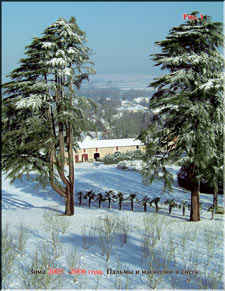
Fig.1 |
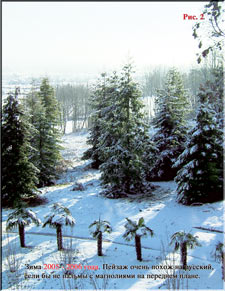
Fig.2 |
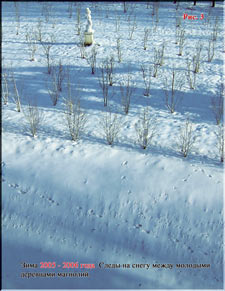
Fig.3 |
Theoretically speaking, palms and magnolias might have perished just from the frost and snow, not to mention the effects of the summer heat. The fact is that plants inevitably suffer from shock after withstanding the relentless effects of the sun for three summer months. As previously mentioned, since the very beginning of our project and the laying out of our park and garden, we have had the active participation of noted French botanist, Professor Gerard Chartier. He is the author of four books on tree and plant life and a prominent specialist in the breeding of plants. By the beginning of winter several trees had died in our park and garden. My wife Svetlana asked him why the trees had been dying. He said with some vexation in his voice that a great many plants are expected to die from shock. He explained that many plants expend their vital energy in order to survive during the heat and then have nothing left to wake up with after the winter. It was a very unpleasant surprise for us to hear this. For Professor Chartier this natural phenomenon was an inevitable evil as well as for all the other botanists and those who deal with soil and plants. They have no choice other than trying to salvage what they can and cut away all the dead trees. Approximately eighty percents of plants die of shock after similar natural ordeals and exposure. As for young and recently seeded plants... they clearly have no chance. After learning about the phenomenon of shock and its cause, I had an idea of how to prevent the death of plants and trees from exhaustion of their vital energy. To implement this I made some changes in the field generator under our castle. The essence of these additional changes is to recover the expended vitality of the plants, thereby saving them from death. And again, as in most cases, my intervention worked. However, before dealing with the results, I would like to explain some aspects. Plants as well as animals have their own spirits. Each spirit consists of the second and third material bodies (the so-called ether and astral bodies). That is why they are able to experience a spectrum of emotions and senses and possess a certain intellect. Plants differ from animal organisms greatly but it does not mean that they are unable to have consciousness. It is simply that their "nervous system" differs dramatically from the nervous system of animal organisms. However, they have "nerves" and do react with their own resources to whatever happens around them and with them. Plants are afraid of death as well as any other living creature. They feel everything — when they will be chopped down, whenever their branches are broken or cut, or even when someone tears off or eats their leaves or flowers, etc. When I first embarked upon my study of nature, one experiment I performed absolutely stunned me. I took a match and slightly seared a leaf on a tree. To my great surprise the whole tree reacted with pain to this seemingly insignificant action! The tree felt that I had seared its leaf and obviously did not like it. Responding to my kind of "innocent" action the tree mobilized all its forces in anticipation of another unpleasant surprise from me and prepared its defenses to meet everything decreed by fate. The tree changed its psi-field quickly preparing itself to retaliate against the enemy with the aid of its field defenses. It is the only weapon (other than the excretion of vegetable poisons, thorns and barbs) that plants have at their disposal. The effects of a riposte (counter-thrust) delivered by a tree or any other plant may not show up at once. However, they result in damages at the level of the assailant’s spirit that later may manifest as a weakening of the body and even illness. Every life form protects itself as best it can and none (including plants) wants to be someone's breakfast, lunch or dinner… I moved away from the suffering tree after such an unusual reaction to my searing its leaf. Almost instantly the tree returned to its normal state... I then asked another person to approach the tree without harming it any way. This time the tree did not alter its state at all. However, when I approached the tree without any matches it immediately reacted defensively — preparing in advance for any possible dirty tricks on my part. The tree had memorized that it was I who did it harm and just in case was prepared for other possible problems on my part. Interesting, isn’t it? A plant, a tree in this case, is able to distinguish psi-fields of different people and memorize those that hurt it. Plants do not have eyes, ears and other sense organs like we do, but they do at the level of fields have their own perceptual apparatus. They "see", "hear" and "communicate" at the field level, communicate telepathically among themselves and possess their own kind of consciousness — though it differs dramatically from the kind we are used to. They experience pain and like any other living creature do not want to die, but they cannot scream with pain as animals do. They simply lack the lungs to create the kind of sounds that we do, but it does not mean that they cannot feel. They express their emotions, senses, and ideas differently than animals, including man. Somehow there is a totally erroneous notion circulating around, that it is bad to eat the meat of animals and fish, etc. because this constitutes the killing of animals. On the contrary, it is believed that, vegetable foods are "created by God" so eating them is "innocent". Allegedly, plants were created in order to satisfy everyone! Actually, there is no difference between eating plants or animals. Whatever the case, to prolong one life it is necessary to take another life. By the same token, fruits and vegetables are not "created" to satisfy somebody's stomachs except for cases wherein the seeds of a new plant life (the plant’s progeny) are hidden in a hard protective coat to save them from being digested. Furthermore, in this case – the juicy flesh of fruits and vegetables around their seeds is intended by nature to provide a nourishing environment for future sprouts. However, the hard shells of angiosperm seeds save them from being digested in stomachs so that after "liberation from their captivity," the organic and inorganic substances accompanying this "liberation" give seeds an opportunity to begin a new life. The fact is that every seed contains the spirit of a specific adult plant, which is "attached" to it. After germination of the seed a growing vegetable organism simply fills this matrix-spirit. In other words, the vegetable biomass simply "fills" and inhabits the blueprint-spirit of this plant during its growth. The spirit of the plant is a matrix, which ultimately determines the size of the adult plant. Several research studies on electric potentials around plant seeds have yielded phenomenal results in this regard. After data processing the results, scientists made the surprising discovery that the three-dimensional projection of measurement data around a buttercup seed perfectly duplicated the shape of an adult buttercup plant. The seed had never been placed in nutrient soil, nor even "broken the egg-shell" yet a matrix of the adult plant was already present. Again we run into his majesty, "Chance." Had the researchers performed this experiment on a cedar nut or an apple-tree seed instead of a buttercup seed the scientists would hardly have succeeded in "seeing" spirits of the larger plants. That would not mean that they are absent. The reason is rather simple – the size of adult plants like the cedar and the apple-tree is too large. That is why nobody would even think about measuring electric potentials at such a distance from the seed on adult vegetation of such magnitude. Then by accident a scientist investigated the seed of a buttercup, which yields an adult plant that is small. And only owing to this was it possible to see a miracle – the spirit of an adult plant attached to a seed... Thus, the spirit of the adult plant is attached to every seed, grain or nut. Therefore, when these seeds germinate, young sprouts begin to grow shaping themselves according to the image and likeness of the spirit and gradually filling it. Up to the moment of formation of the adult plant the size of the immature plant and the size of the spirit more or less coincide. The field generator which I placed under our castle operates as follows: it saturates the spirits of our plants with certain specific streams of primary matters that give rise to the development of plant spirits. This causes them to increase in size and consequently the plants also increase in size. However, a "simple" increase in the size of the spirit will not result in the gigantism of plants. It is imperative, that the volume of the vegetable biomass created within a unit time of the active growth period correspond to the given size of the plant’s spirit. This is only possible if we change the value of the Biological Degree of Efficiency (BDE). The BDE of angiosperm plants is capable of reaching 10%. (See Nicolai Levashov, Final Appeal to Mankind, Chapter 4). Therefore, in order to match shape with content, the field generator changes the BDE of plants several times over. Thus, the plants’ chromosomes are minimally altered. As a result, young nursery transplants and the seeds of the adult plants respond maximally to the influence of the field generator. And now a few observations as to why plants experience shock and die of it. During spring and summer plants foliate, blossom and bear fruit and also actively synthesize their vegetable biomass. At that level the exchange processes in plants are at their highest. As a result, the bodies (astral and ether) of the plants’ spirits are actively saturated with streams of primary matters, which provide photo-synthesis. During the spring - summer period the spirits of the plants receive maximal saturation with primary matters. After that the processes of exchange slow down to a minimum. With angiosperm plants it happens when they shed their leaves; with gymnosperm plants, when the cold weather is setting in. At this moment of hibernation the spirits of plants achieve the highest level of saturation with primary matters. During spring warming this super-saturation of the spirits of plants creates and directs the stream of primary matters towards the physically dense bodies of plants. This additional saturation accelerates exchange processes within the plants while the ambient temperature is still quite low, and exactly this phenomenon allows plants to "awaken" after their hibernation. Moreover, this super saturation of the plants’ spirits during their hibernation plays the same role as a bear’s fat. The slow flow of primary matters from the spirits of the plants to their physically dense bodies maintains them at a life-support level. Plants create this winter supply during the spring and summer. The amount of their "winter fat" and the degree of surplus saturation of the plants’ spirits depend upon the weather conditions. The more favorable they are the greater the "winter fat" and the higher degree of surplus saturation. In case of drought and strong heat plants already begin to "burn" their winter supply in the summer in order to survive. Such unfavorable environmental conditions thrust plants into a state close to hibernation. Only in this case the absence of water does not result in their death. Deceleration of exchange processes to the minimum during a drought preserves arboreal sap – the blood of plants. It is purely a protective mechanism. If the drought is not too long the effects of such "hibernation" in midsummer are insignificant for plants and they can quickly restore their needed supply of "winter fat". In case of long-drawn out drought plants do not have time to recover the optimum level of surplus saturation of their spirits by primary matters. That is why at the beginning of a fall - winter period, the remaining supplies of "winter fat" are not enough to maintain the life support level of exchange processes. What remains of the plant spirits’ super-saturation by primary matters can maintain their vitality at the life-support level. However, as this surplus is consumed, the vital processes within the plants slow down more and more until almost fully extinguished. Plants then enter a metabolic state of "clinical death". If at this moment there is no further active saturation of plants’ spirits by primary matters up to the viable level, plants remain in a state of "clinical death" and entirely succumb. Since there is no reason to expect a sharp rise in temperature during the winter ... plants begin to die. Therefore, the only way to rescue our plants from this sorrowful lot was to saturate their spirits with primary matters up to the optimum level, to restore their failing «winter fat». To this end I made some alterations in the field generator that began saturating the plants’ spirits and they, in turn, started "putting on flesh" before our very eyes. Now we had only to wait for their spring awakening... At the beginning of spring almost all our trees and plants came back to life — even those, which were already marked as dying. Life actually awakened in them again — as if exiting their "clinical death". I had never done anything like that before. It turned out that plants could experience "clinical death" and that it was also possible to help them out of it. To our great joy our park and magnolia garden began to come back to life after suffering both the sultry and dry summer and the extraordinarily cold and snowy winter. In the beginning of March, the magnolias already had their first buds even as unexpected frosts struck and all buds were covered with ice (Puc.4). Every bud was encrusted with ice and turned into an icicle. And for several days there were pretty strong night frosts. When they finally stopped, all buds turned black and fell off. Most harmful for trees and plants is when frosts strike after the plants’ "blood" (arboreal sap) begins to move from roots through a trunk to their branches. And then… it was raining almost without a break. Sometimes all day and night. There was so much water, it was as if it had filled all possible empty spaces in the earth and had begun to ooze out through the soil like blood from a wound. All rivers of the Valley of Kings overflowed and bridges across the Cher and Vienne rivers became inaccessible to any transportation for almost for a month. All inhabitants of the valley had to reach the nearest cities via detours. However, even these spring gifts of nature were unable to stop our magnolias. Darkened buds fell off and new ones appeared in their stead. After such a cold spring magnolias "opened their eyes" for the first time and again a pleasant surprise was awaiting us. Usually the first spring magnolia flowers are smaller than the second or third crop. In the first article The Source of life-1I described magnolias of the last flowering, which had to be the largest. The dimensions of magnolia flowers that have already blossomed out are staggering as well as, one might say, their star beauty. For example, the magnolia "John John", a hybrid found by Tod Gresham, is of unknown origin. The flowers of this magnolia attain a maximum of 20 cm in diameter. It was bred and named by John Allen Smith in a magnolia nursery from the small town of Chunchula, Alabama. Tod Gresham discovered this hybrid there and placed it in the Gloster Arboretum, a famous tree nursery. In our magnolia garden the first, "smallest" flower that bloomed was the magnolia "John John" at «just» 48 cm in diameter!!! (Puc.5). I call special attention to this — since it happened after such unusual environmental conditions during last summer and winter of 2005-2006 and after the frosts in March. Moreover, the next day the "eye" of another bud of this magnolia opened and we were staggered by its size — the diameter of the flower was 52 cm!!! (Puc.6). Usually flowers of this magnolia have simple even petals. In the picture we can clearly see not only the enormous size of its flowers but also a further result — namely, that the petals of these flowers had changed to a wavy configuration... |
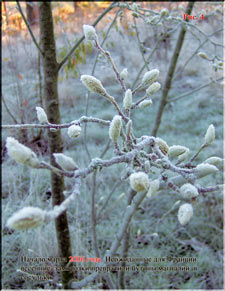
Fig.4 |

Fig.5 |
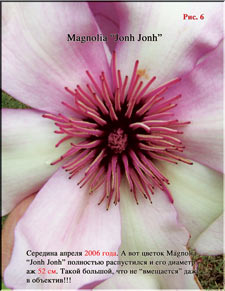
Fig.6 |
Flowers of another magnolia "Batty" (M. kobus var.stellata "Rosea" (M. liliiflora "Nigra")) also began to bloom in our garden. This hybrid was first shown public in the US National Arboretum. It was obtained by William Kosar using a method of cross pollination in 1956. Our "Batty" had been changed even from the inside and its flowers became much bigger than all "other" "Batty"s’ (Puc.7 and Puc.8). Another magnolia "decided" to change. Magnolia with a strange name "Wada's picture" named so by the Chinese selectionist Wada usually reaches 15-18 cm. We still have the first half-open buds of 26-30 cm (Puc.9). |

Fig.7 |
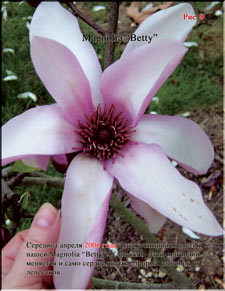
Fig.8 |
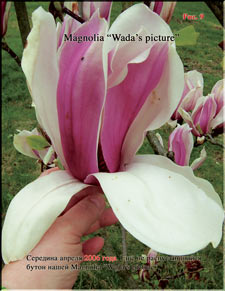
Fig.9 |
With every day the buds of magnolias in our garden are becoming bigger and bigger including magnolia "Wada's picture"! (Puc.10). These are new "heroes" of our garden. Last year they did not have time to "react" to the influence of the field generator, but at the beginning of this year they "decided" to repair an "omission" and succeeded in it extremely well! |

Fig.10 |
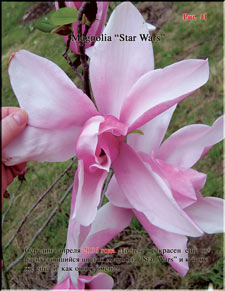
Fig.11 |

Fig.12 |
However, the last year "record-holders" are not lagging behind. We have only to glance at the half-opened flowers of magnolia «Star Wars» to make sure of it (Puc.11, Puc.12, Puc.13, Puc.14, Puc.15). |
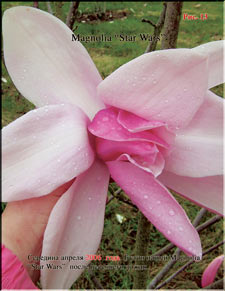
Fig.13 |
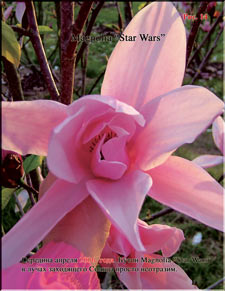
Fig.14 |
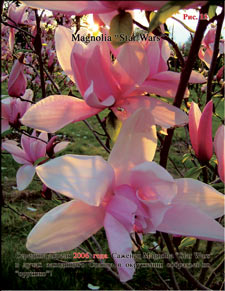
Fig.15 |
The flowers of magnolia "Iolanthe" hold their position too. The flowers of this magnolia the are enormous and tender as usual (Puc.16, Puc.17, Puc.18, Puc.19, Puc.20). |

Fig.16 |

Fig.17 |
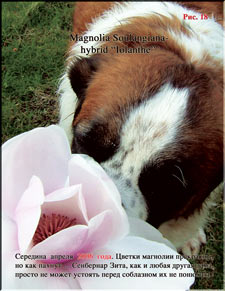
Fig.18 |
The sizes of "old" heroes also did not surrender. Some of them, for example, flowers of magnolia «Star Wars» became almost twice as large as they were last year. It is very unusual to see enormous flowers, a half-meter in diameter, on young nursery transplants of magnolias, the trunks of which, compared to the size of the flowers, look like fragile thin reeds. Spring is a time of year when every day nature, awakening from hibernation, changes the face of the earth. Every day new buds blossom; every day new sprouts sing the song of life as they wake up beneath the sun’s rays. Another day of a spring "outburst" of nature — and buds of another magnolia open their eyes to welcome the world, preening in their splendor, as if exclaiming to the universe: "Look, how wonderful we are!" The universe is enchanted with this hymn of life, not to mention us, "sinful" human. |
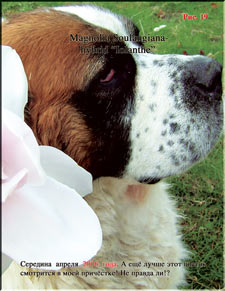
Fig.19 |
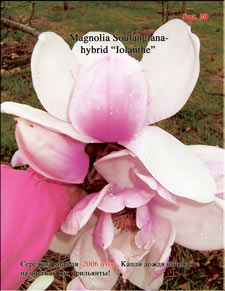
Fig.20 |
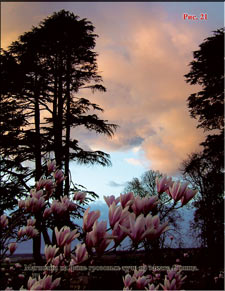
Fig.21 |
Everybody’s soul will "sing" in response to the beauty of nature and the force of awakening life (Puc.21, Puc.22). The heart swells involuntarily seeing the harmony of beauty created by man surrounded by nature’s beauty. Professor Gerard Chartier could not miss the miracle of our magnolia buds opening. It was simply impossible for him, being a noted specialist in the life of plants, to fail seeing with his own eyes this mystery of nature augmented by the «mystery» of the phenomenon of our park and magnolia garden (Puc.23). He is not in the know as to the real cause of our "wonders", but as an independent (but not indifferent) observer, Professor Chartier, a true scientist, considers his observation of the existent phenomena as the gift of fate and his life-work. Even at Eastertide, which in France is celebrated as a national holiday, he undertook two hours’ journey, on Friday April 14, to spend the entire day among the blossoming of our magnolia flowers and see this "miracle" of nature with his own eyes (Puc.24). |
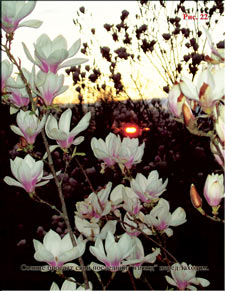
Fig.22 |
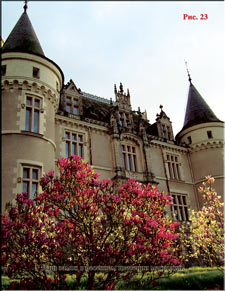
Fig.23 |
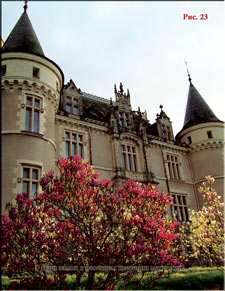
Fig.24 |
Almost every new day of spring welcomes us with new surprises. The first spring buds of magnolia "Ricki" have opened. Magnolia "Ricki" — M.kobus var. stellata (Magnolia liliiflora "Nigra") — was bred by Dr. Francis de'Vos using cross pollination in 1955. The petals of flowers of this magnolia are red-violet outside and light rose inside. The maximum size of flowers is 10-15 cm in diameter, while in our garden the spring flowers of this magnolia are already 25-26 cm in diameter! (Puc.25). Along with magnolia "Ricki", magnolia "Sundew" has opened its "eyes" and buds. This hybrid of unknown origin has light-rose flowers of 10-15 cm in diameter. In our garden the diameter of flowers of this magnolia is already 26-28 cm (Puc.26, Puc.27). |

Fig.25 |
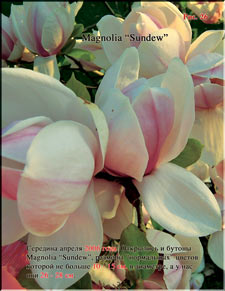
Fig.26 |
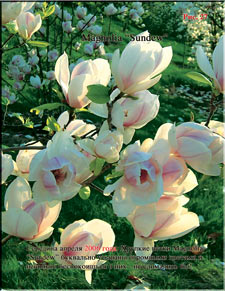
Fig.27 |
Yet not only plant-"aristocrats" react to the field generator so exuberantly. The first leaves of Spanish Sorrel have already forced their way through last year's grass (Puc.28). It would seem there is nothing in particular about this sorrel, if it were not for the size of its leaves in our park (Puc.29) . |
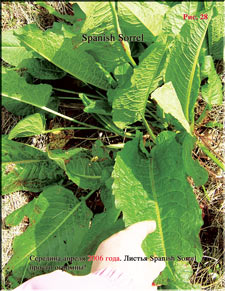
Fig.28 |
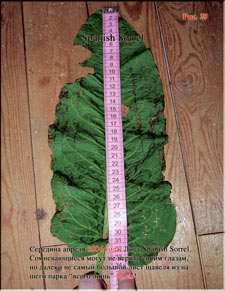
Fig.29 |
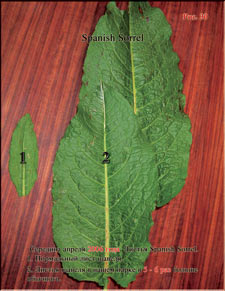
Fig.30 |
The leaves of "our" sorrel are "just" 34-40 cm long, 5-6 times larger than "normal" ones. The leaves of ordinary sorrel are sourish, slightly rigid and quite dry.
The leaves of our sorrel not only became enormous compared to normal ones but also juicy with a pleasant sweet-and-sour taste. They gained succulence and their "skeleton"
became vigorous with every vein of the leaf bursting with force and internal power. They are simply saturated with vitality. To verify that, it is enough to compare the leaf of
ordinary sorrel and "ours" (Puc.30)*. In the case of the sorrel it is possible not only to see the "miracle" but also to taste it and to judge the gustatory qualities of its changed
leaves. One can only imagine the taste of a soup seasoned with such leaves. And these are only the first "swallows" of spring changes in our park and magnolia garden.
And now we are awaiting new unbelievable "marvels" that will happen under the influence of the field generator. We will see... * To learn more about varieties of magnolias see "The Illustrated Encyclopedia of Trees" by David More and John White, Timber Press, 2002.
|
| Main Page : About Me : Advice : Articles : Books : Curiosities : Paintings : Photographs : Seminars : Source of Life : Svetlana : Video |